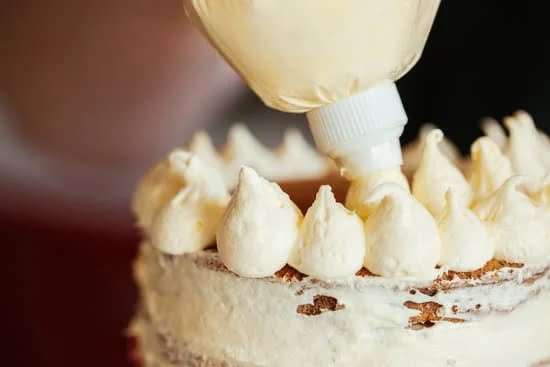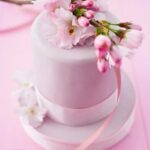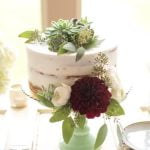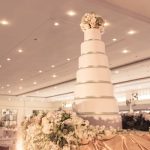Are you looking to learn how to decorate a cake without frosting? Traditional frosting can be too sweet or heavy for some, and sometimes we just want to break the mold and try something different.
In this article, we will explore various alternative decorating methods that can elevate your cake without relying on traditional frosting. Whether it’s using whipped cream, fresh fruit, chocolate ganache, or edible flowers, there are countless creative ways to adorn a cake without the typical buttercream topping.
Choosing the right type of cake is crucial when opting to decorate without frosting. Certain types of cakes, such as sponge, chiffon, or naked cakes, work best for these alternative decorating methods. We will discuss the characteristics of these cakes and why they are ideal for decorating without traditional frosting.
In addition to exploring various filling and layering options that can add flavor and texture to the cake without relying on frosting, we will also provide tips and techniques for using whipped cream as a frosting alternative for decorating. This includes piping and rosette designs that can add elegance and flair to your cake without traditional frosting.
Choosing the Right Cake
When it comes to decorating a cake without traditional frosting, the type of cake you choose plays a crucial role in the overall success of the decoration. Sponge, chiffon, and naked cakes are some of the best options for decorating without frosting due to their light and airy texture, as well as their ability to absorb other flavors and fillings.
Sponge cakes, for example, have a porous structure that allows them to soak up syrups, fruit juices, or liqueurs, making them ideal for creating moist and flavorful layers without relying on frosting.
Chiffon cakes are another great choice for decorating without frosting, as their delicate crumb and spongy texture make them a perfect canvas for various fillings and decorative elements. Their lightness also makes them compatible with whipped cream toppings or ganache designs. Naked cakes, which are essentially unfrosted or partially frosted cakes that showcase their layers and fillings on the outer edges, provide an opportunity for creative presentation through decorative embellishments without the need for traditional frosting.
Ultimately, choosing the right cake is essential for achieving successful decoration without frosting. These types of cakes offer versatility and flexibility when it comes to incorporating different flavor profiles and visual appeal into the cake design.
Whether you opt for a sponge cake infused with citrus syrup, a chiffon cake filled with fresh berries and cream, or a naked cake adorned with edible flowers and herbs, selecting the appropriate cake sets the stage for creating a beautifully decorated confection without relying on frosting.
Layering and Filling
When it comes to decorating a cake without frosting, choosing the right type of cake is crucial. Sponge cakes, chiffon cakes, or naked cakes work best for this purpose as they offer a sturdy yet light base that can hold up well without a layer of traditional frosting. These types of cakes also allow for creative layering and filling options that can add flavor and texture to the cake without the need for frosting.
One popular option for layering and filling a cake without frosting is using fruit preserves or curds between the cake layers. Fruit preserves such as raspberry, strawberry, or apricot can add a burst of fruity flavor while providing moisture to the cake layers. Similarly, lemon curd, passionfruit curd, or mango curd can bring a tangy and refreshing element to the cake without relying on frosting.
In addition to fruit preserves and curds, other non-frosting filling options include pastry cream, whipped cream with fresh berries, or even layers of mousse. These fillings not only enhance the taste of the cake but also contribute to its visual appeal. With some creative layering techniques, such as alternating different fillings between each layer or creating decorative patterns within the layers, it’s possible to elevate the overall look of the cake without using traditional frosting.
| Filling Options | Description |
|---|---|
| Fruit Preserves | Provides fruity flavor and moisture between cake layers |
| Lemon Curd | Brings tangy and refreshing element to the cake |
| Pastry Cream | Adds richness and creamy texture to the layers |
| Whipped Cream with Fresh Berries | Combines lightness from whipped cream with bursts of flavor from fresh berries |
Whipped Cream Decorations
Decorating a cake without traditional frosting opens up a world of creative possibilities, and one alternative that is both delicious and versatile is whipped cream. Whipped cream can be used to add a light and airy topping to a cake, creating beautiful designs and textures without the heaviness of traditional frosting. Whether you’re looking to create elegant rosettes or intricate piping designs, using whipped cream as a decorating option can take your cake to the next level.
Techniques for Using Whipped Cream
When using whipped cream as a frosting alternative for decorating, it’s essential to ensure that the cream is properly whipped to achieve the right consistency. The key is not to over-whip the cream, as it can become too stiff and difficult to work with.
It’s important to use chilled equipment and cold heavy whipping cream to achieve the best results. Additionally, stabilizing agents such as gelatin or powdered sugar can be added to help the whipped cream hold its shape for longer periods.
Piping and Rosette Designs
One of the most popular ways to decorate a cake with whipped cream is by using piping techniques to create beautiful designs. Using different piping tips, you can create intricate patterns, borders, and even personalized messages on your cake. Rosettes are another stunning design option that adds an elegant touch to any cake. By mastering these techniques, you can elevate your cake decorating skills while avoiding traditional frosting.
Whipped cream offers endless opportunities for creativity when it comes to decorating cakes without using frosting. With some practice and experimentation, you can discover new ways to use whipped cream as a delicious and visually appealing alternative for decorating your cakes.
By incorporating whipped cream into your cake decorating repertoire, you’ll have access to a wide array of options for creating stunning designs that are sure to impress your family and friends – all without relying on traditional frosting. Whether you’re looking for something light and airy or rich and decadent, whipped cream offers a versatile way to add a finishing touch to any cake.
Fresh Fruit and Nut Decorations
Fresh fruit and nuts can be a delightful and healthy way to add flavor and visual appeal to a cake without the use of traditional frosting. Not only do these natural decorations provide vibrant colors and textural contrast, but they also infuse the cake with natural sweetness and nutritional benefits.
Whether you’re looking to create a stunning summer fruit-topped dessert or add a sophisticated touch with roasted nuts, there are countless ways to elevate your cake with fresh produce.
Choosing Fresh Fruit
When selecting fruit for decorating a cake, it’s essential to consider both the flavor profile and the color contrast it will provide. Berries such as strawberries, blueberries, raspberries, or blackberries make for visually striking decorations and offer a burst of tartness that balances the sweetness of the cake. Slices of kiwi or mango can add an exotic touch, while citrus fruits like oranges or lemons can bring brightness and zesty flavor to the dessert.
Nuts for Texture
Nuts are another fantastic option for adding texture and nutty flavor to a cake without frosting. Toasted almonds, pecans, walnuts, or pistachios can be sprinkled on top of the cake or used to create intricate patterns along the sides. For a more decadent touch, consider candying the nuts before using them as decorations – this will not only enhance their flavor but also create a glossy sheen that adds visual interest.
Arranging Fresh Fruit and Nut Decorations
When it comes to arranging fresh fruit and nuts on top of a cake, it’s all about creativity and balance. Consider layering thinly sliced fruit in concentric circles for an elegant look or scattering berries randomly for a rustic feel.
Nuts can be arranged in geometric patterns or utilized to form borders around the edges of the cake. It’s important to consider how the textures and flavors interact with each other when arranging these decorations – after all, visual appeal should always be complemented by delicious taste.
Chocolate and Ganache Designs
When it comes to decorating a cake without traditional frosting, melted chocolate and ganache can be incredibly versatile and visually stunning options. These ingredients can be used to create intricate designs and patterns that add an elegant touch to any cake. Here are some tips for using chocolate and ganache to decorate your cake without relying on frosting:
- Use a piping bag with a small tip to create delicate designs with melted chocolate or ganache. You can draw lines, swirls, or even write messages on the cake surface.
- Consider creating a marbled effect by swirling different shades of melted chocolate or ganache together before applying it to the cake. This technique adds a beautiful aesthetic to the dessert.
- Use stencils or molds to create specific shapes and patterns with melted chocolate or ganache. This allows for more precise and professional-looking decorations on the cake.
Melted chocolate and ganache offer endless possibilities for decorating cakes without traditional frosting, making them ideal choices for those looking for alternative methods. Whether you’re aiming for a sleek and modern design or something more whimsical, these ingredients can help you achieve the look you desire. Experiment with different techniques and have fun incorporating chocolate and ganache into your cake decorating process.
Edible Flowers and Herbs
Using edible flowers and herbs to decorate a cake can be a unique and natural way to add both aroma and visual appeal without relying on traditional frosting. Not only do these natural adornments make for a stunning presentation, but they also offer a delightful sensory experience for anyone enjoying the cake.
When choosing edible flowers for cake decoration, it is important to ensure that they have not been treated with any chemicals or pesticides that could be harmful if consumed.
Some popular edible flowers that are commonly used for cake decoration include roses, violets, pansies, lavender, and daisies. These delicate blooms can be carefully arranged on top of the cake or scattered along the sides to create a beautiful and romantic aesthetic. Edible herbs like rosemary, thyme, mint, and basil can also be used to add a touch of greenery and herbal fragrance to the cake.
When adorning a cake with edible flowers and herbs, it is essential to consider the overall flavor profile of the cake. For instance, pairing lavender blossoms with a lemon-infused sponge cake can create a lovely floral-citrus combination. Additionally, incorporating aromatic herbs like mint or basil into the filling or layers of the cake can enhance its taste without the need for excessive frosting.
Incorporating edible flowers and herbs into cake decorating not only provides an alternative to traditional frosting but also elevates the visual and olfactory experience of enjoying a slice of cake. Whether you are celebrating a special occasion or simply want to indulge in a beautifully decorated dessert, experimenting with these natural adornments can bring a touch of elegance and freshness to your homemade cakes.
Adding edible flowers and herbs as part of your creative repertoire will surely impress your guests while offering them something truly unique and delightful.
Final Touches and Presentation
Decorating a cake without traditional frosting opens up a world of creative possibilities for adding the perfect finishing touches. Once the cake has been filled and decorated with whipped cream, fresh fruit, nuts, chocolate, or ganache, it’s time to add those extra elements that will elevate the presentation to a whole new level. Here are some tips for adding the final touches to your beautifully decorated cake:
- Dusting with Powdered Sugar: A light dusting of powdered sugar can add visual appeal and a touch of sweetness to the finished cake. Use a fine-mesh sieve or sifter to evenly distribute the sugar over the top of the cake.
- Adding Edible Glitter: For a touch of sparkle and glamour, consider using edible glitter to enhance the appearance of your decorated cake. There are various colors and sizes of edible glitter available that can complement your chosen decorations.
- Arranging Fresh Flowers: Fresh flowers can make for a stunning and elegant cake decoration. Ensure that the flowers you choose are safe for consumption and free from pesticides or other harmful chemicals. When arranging the flowers on the cake, consider creating an aesthetically pleasing composition that complements the overall design.
These simple yet impactful finishing touches can take your decorated cake from ordinary to extraordinary, providing visual appeal as well as enhancing the overall flavor profile. Whether you opt for a dusting of powdered sugar, edible glitter, or fresh flowers as a finishing touch, these details will not only make your cake look beautiful but also leave a lasting impression on anyone who has the pleasure of enjoying it.
Remember, when considering how to decorate a cake without frosting, creativity knows no bounds – so feel free to experiment with different combinations and techniques until you find what works best for you and your unique design vision.
Conclusion
In conclusion, there are numerous creative and delicious ways to decorate a cake without relying on traditional frosting. From choosing the right type of cake to exploring various filling options, using whipped cream, fresh fruit, nuts, chocolate designs, and even edible flowers and herbs, the possibilities for decorating a cake are truly endless.
By incorporating these alternative decorating methods, not only can you create visually stunning cakes but also offer unique flavors and textures that go beyond the typical sweetness of frosting.
One of the key benefits of decorating a cake without frosting is the opportunity to experiment with different ingredients and techniques. Whether it’s mastering the art of piping or exploring the natural beauty of edible flowers, decorating a cake without frosting opens up a world of creativity for both amateur bakers and experienced pastry chefs alike.
Additionally, these alternative methods allow for a lighter and fresher approach to cake decoration, perfect for those who prefer desserts that are not overly sweet or heavy.
So next time you’re in the kitchen baking a cake for a special occasion or just because, consider stepping outside the box and trying your hand at decorating without frosting. With this guide as inspiration, you can discover how to decorate a cake without frosting in ways that are both beautiful and delicious.
Let your imagination run wild as you explore new flavors, textures, and design techniques to create a stunning masterpiece that will surely impress your friends and family.
Frequently Asked Questions
How Do You Decorate a Plain Cake?
Decorating a plain cake can be done in several ways. You can use fresh fruit to create a colorful design, or try piping whipped cream for a simple but elegant look. Another option is to dust the cake with powdered sugar for a quick and easy decoration.
What Can You Use Instead of Buttercream for Cake Decorating?
If you want to avoid using buttercream for cake decorating, there are some alternatives you can consider. Cream cheese frosting is a popular choice that adds a tangy flavor to the cake. Whipped ganache can also be used for a rich and indulgent frosting without buttercream.
How Do You Write Your Name on a Cake Without Icing?
Writing your name on a cake without icing can be achieved using other edible materials such as fondant or marzipan. These can be rolled out and shaped into letters to spell out your name without the need for traditional icing. Another option is to use decorative edible markers to write directly onto the cake surface for a personalized touch.

Welcome to our cake decorating blog! My name is Destiny Flores, and I am the proud owner of a cake decorating business named Cake Karma. Our mission is to provide delicious, beautiful cakes for all occasions. We specialize in creating custom cakes that are tailored specifically to each customer’s individual needs and tastes.





